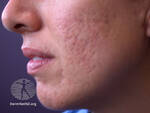FightAcne.com Interview with:
Christopher J. Thang, BS
John Sealy School of Medicine
The University of Texas Medical Branch, Galveston
Department of Dermatology
Massachusetts General Hospital
Harvard Medical School, Boston
Jenny Lai, PhD
Harvard Medical School,
Department of Dermatology
Brigham and Women’s Hospital
Boston, Massachusetts
John S. Barbieri, MD, MBA, Senior Author
Department of Dermatology
Brigham and Women’s Hospital, Boston, Massachusetts
Associate Editor, JAMA Dermatology
FightAcne.com: What is the background for this study?
Response: Calcitonin gene-related peptide (CGRP) mediates neurogenic inflammation and vasodilation. Prior research has demonstrated increased CGRP expression in the skin of rosacea patients who experience flushing. CGRP signaling has also been implicated in acne pathogenesis. CGRP inhibitors are used for the prevention and treatment of migraines. We investigated whether CGRP inhibition for migraine patients is associated with a decreased risk of developing acne or rosacea.
Continue reading








